SWT/KWS MT. KENYA MOBILE VETERINARY UNIT


FEBRUARY 2023

Introduction
20 Cases in February 4 Rhino Cases 6 Elephant Cases
February Report by Dr.
 Jeremiah Poghon
Jeremiah Poghon
In February 2023, the Mt Kenya Wildlife Veterinary Unit attended to 20 cases requiring urgent veterinary intervention in the Laikipia ecosystem and Mt. Kenya region. These comprised 4 rhino cases, 6 elephant cases, 5 bongo cases, 2 Rothchild’s giraffe cases, 1 Grevy’s zebra case, 1 lion case, and 1 buffalo case. The Vet Unit rescued a 3-day-old white rhino calf in Ol Pejeta Conservancy. The calf was too weak to keep up with its mother and was abandoned. Given the prevailing drought its mother was not able to produce enough milk. However, we are happy to report that the calf is now doing well at the Ol Pejeta nursery.
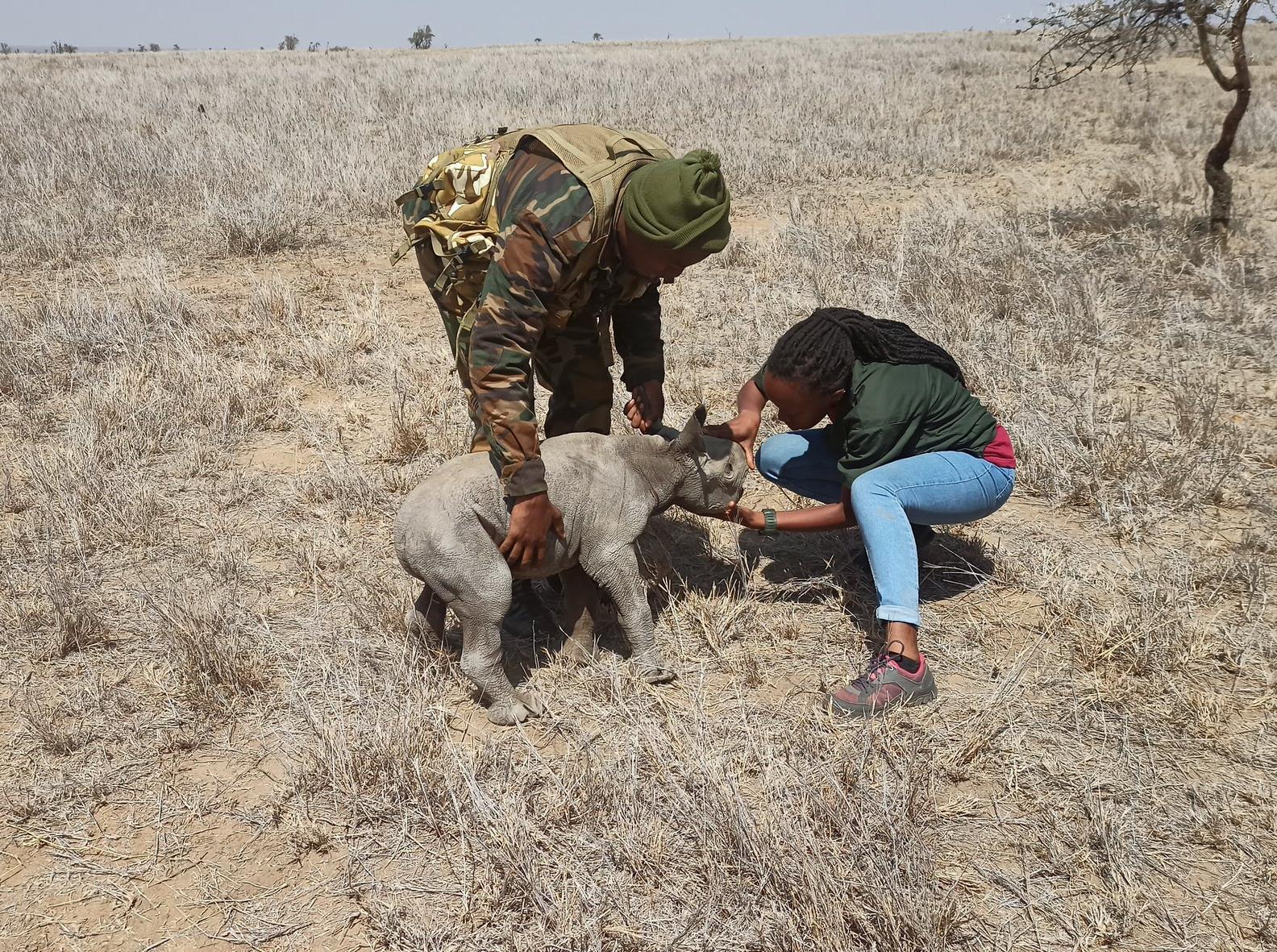

Acknowledgement
The Mt. Kenya Wildlife Veterinary Unit acknowledges the Senior Assistant Director, Mountain Conservation Area and the Head of Veterinary Services, Kenya Wildlife Service for providing leadership and technical expertise. The unit also appreciates Sheldrick Wildlife Trust (SWT) for providing the financial and logistical support that facilitates the unit in delivering its mandate.
Case Details
Date Species Area Found Reason for Intervention Outcome 01-Feb 23 Elephant Samburu N.R. Natural Causes Adult female elephant with severe lameness and “rotting” of the distal right hind limb Successfully treated 02-Feb 23 Giraffe Mwea N.R. Snared Two adult female Rothchild giraffes with lower limb snares Successfully treated 03-Feb 23 Bongo Mt. Kenya Conservancy Natural Causes Adult female mountain bongo with a large abdominal wound Successfully treated 06-Feb 23 Bongo Mt. Kenya Conservancy Relocation Relocation of an adult female bongo to another boma after a territorial fight Task successful 08-Feb 23 Rhino Ol Jogi Conservancy Rescue Weak 3-day-old female black rhino calf unable to keep up with its mother Task successful 08-Feb 23 Zebra Pingwan, Laikipia Snared Adult female Grevy’s zebra with a snare on the right forelimb Successfully treated 09- Feb 23 Lion Lolomarik Farm HWC Adult male lion reported to be preying on livestock. Translocated to Meru N.P. Task successful 09-Feb 23 Bongo Mt. Kenya Conservancy Postmortem Female mountain bongo calf died the night before shortly after being born Died. Acute Pneumonia 10-Feb 23 Rhino Solio Ranch Postmortem Adult male white rhino carcass found in a river within Solio ranch Died. Territorial fight 13-Feb 23 Bongo Mt. Kenya Conservancy Natural Causes Adult female mountain bongo reported to be limping Successfully treated 13-Fe 23 Elephant Buffalo Springs N.R. Snared Lame sub-adult male elephant with a snare on its left hindlimb Successfully treated 14-Feb 23 Rhino Ol Pejeta Conservancy Technical Case Reproductive ultrasounds on Curra and Dali, surrogates for Northern White Rhino embryos Task successful 15-Feb 23 Rhino Ol Pejeta Conservancy Technical Case Electroejaculation on Ouwan to determine whether the sterilization was successful Task successful 15-Feb 23 Elephant Daaba, Isiolo County Bullet wound Sub-adult male elephant reported to be lame Successfully treated 15-Feb 23 Elephant Buffalo Springs N.R. Natural Causes Adult matriarch with notable lameness Successfully treated 15-Feb 23 Bongo Mt. Kenya Conservancy Postmortem Adult female mountain bongo was reported to have died the previous night Died. Hypovolemic shock 17-Feb 23 Elephant Ol Pejeta Conservancy Natural Causes Adult female elephant reported to be weak and recumbent Successfully treated 22-Feb 23 Buffalo Namunyak Conservancy HWC Adult male buffalo with a spear lodged in its flank Successfully treated 26-Feb 23 Elephant Kirimon, Laikipia Spear Sub-adult elephant bull with a penetrating wound on the lumbar area Successfully treated
SWT/KWS Mt. Kenya Mobile Vet Unit Treatment Locations

February 2023
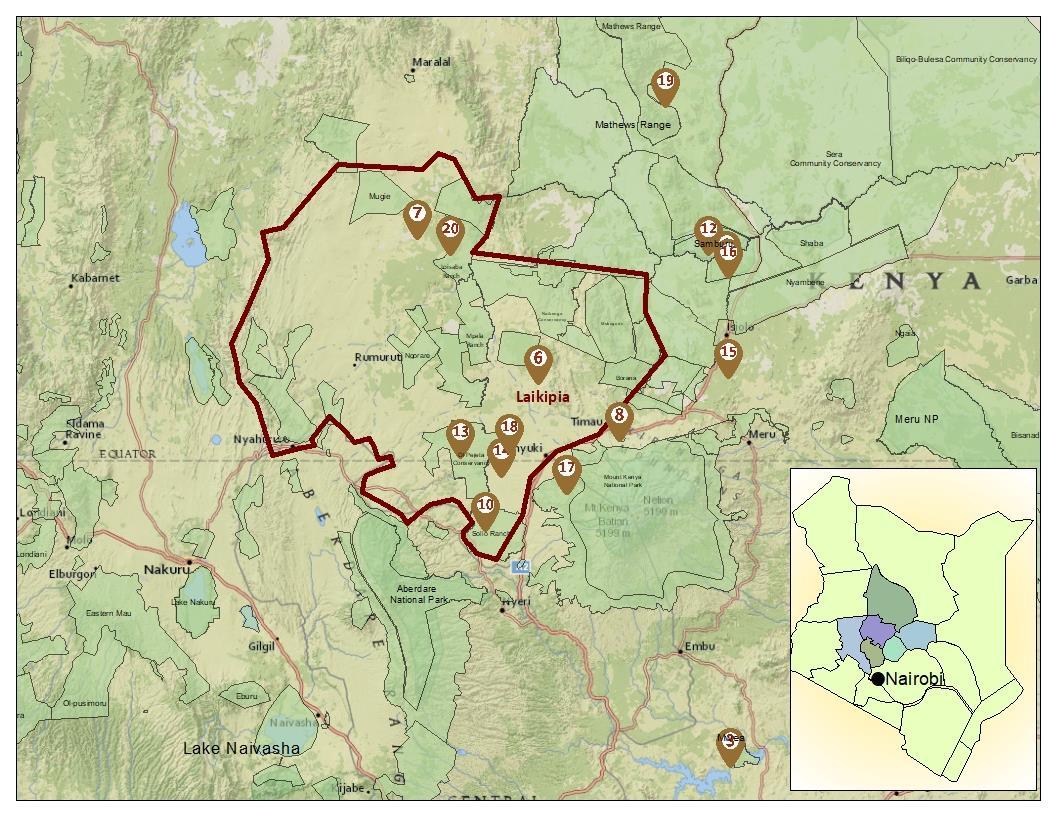
Elephant Natural Causes Samburu National Reserve
An adult female elephant was reported to have severe lameness and “rotting” of the distal right hind limb. She was noted to be in a lot of pain and rarely ventured away from the banks of the Ewaso Ngiro River.
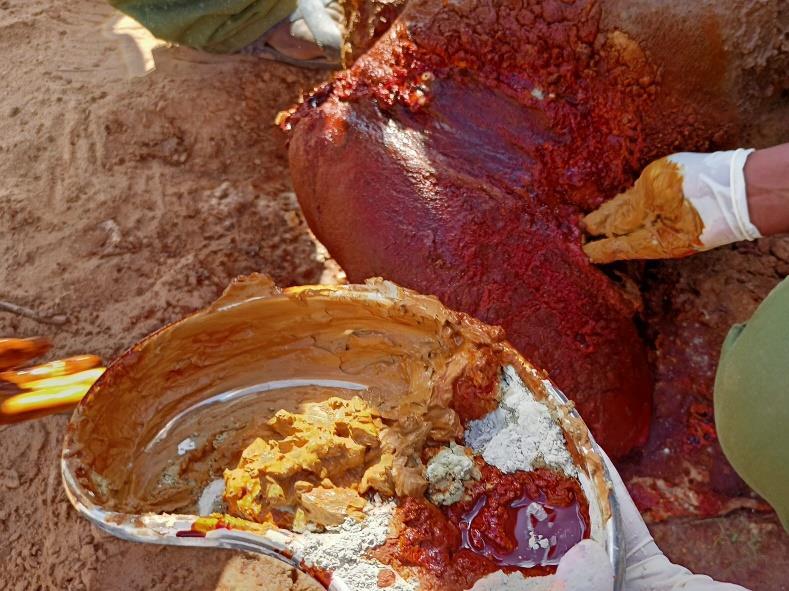



Immobilisation, examination and treatment
The elephant was approached on foot and darted with 17mg Etorphine hydrochloride. The dart landed on the musculature of the right shoulder, and induction time was 7 minutes. The animal went down in left lateral recumbency and was blindfolded.
The distal right hind limb had severe necrosis suspected to be caused by pododermatitis, the possibility of septic arthritis in the joint was also suspected. The wound was debrided with Hydrogen peroxide and Iodine then Clotrimazole pessaries were inserted. It was then sealed with healing clay and topical antibiotic spray applied. Amoxicillin was given intramuscularly and Phenylbutazone administered to manage pain and inflammation. A metabolic stimulant was also given to promote appetite and boost immunity. Anaesthesia was reversed with 425 mg Naltrexone administered via the ear vein.
Prognosis
Prognosis is guarded due to the extensive infection and necrosis. The case will be reviewed in 3 weeks.
Case 1 – 01st February 2023
Giraffe Snared Mwea National Reserve
Two adult female Rothchild giraffes were reported to have lower limb snares at Mwea National Reserve. Snaring is a rampant problem within the Reserve.

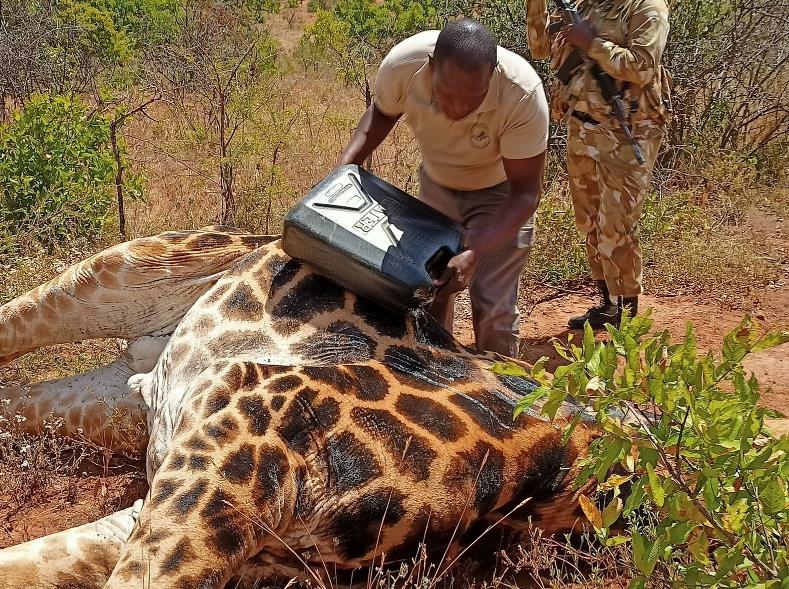


Immobilisation, examination and treatment
The giraffes were attended to in turn with each giraffe being darted with 17mg Etorphine. Induction time was 7 minutes for both animals. The animals went down in lateral recumbency and were blindfolded to avoid light stimulation. Anaesthesia reversal was done immediately with each animal receiving 240mg Naltrexone. The animals were then manually restrained. The snare on the 1st giraffe was noted to have caused some trauma. The snare was removed then Iodine was poured on the wound for topical antibiotic cover. Systemic Amoxicillin was also administered for systemic antibiotic cover alongside Phenylbutazone to cover for pain. The snare on the 2nd giraffe was easily removed with no trauma to the surrounding tissues and musculature. No further treatment was necessary.
Prognosis
Both giraffes were given a good prognosis
Case 2 & 3 – 02nd February
2023
Bongo Natural Causes Mt. Kenya Wildlife Conservancy
The monitoring team reported that an adult female mountain bongo had sustained a large abdominal wound after a territorial fight


Immobilisation, examination and treatment
The bongo was darted with 5mg Etorphine and 40mg Azaperone. The drug took effect 7 minutes later with the animal in lateral recumbency. Oxygen was supplemented intra-nasally and the animal was blindfolded. Examination revealed protrusion of the intestines from the wound. The intestines were thoroughly lavaged with Ringer’s lactate to remove debris and prevent drying out. Thereafter, sections of the intestine that were traumatized and necrotic were dissected and the edges apposed. The intestines were then flushed and repositioned before the abdominal wall layers were closed. Intravenous fluids were given throughout the surgery, and a heavy dose of antibiotics and anti-inflammatories administered. The animal was moved to the nursery area for its safety and to ensure keepers can monitor it hourly. Anaesthesia was reversed with 100 mg Naltrexone injected intravenously. The bongo stood 4 minutes later.
Prognosis
Guarded to poor prognosis as the bongo’s injuries were extensive and abdominal pressure from its pregnancy would not help with healing. The animal to be closely monitored and given soft feeds with plenty of water.
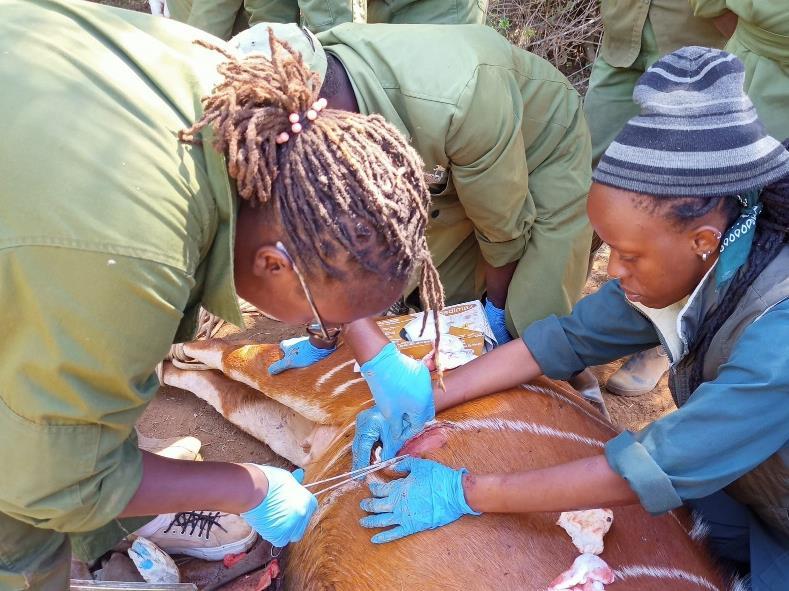

Case 4 – 03rd February
2023
Bongo Relocation
Mt. Kenya Wildlife Conservancy
The Mt. Kenya Conservancy team requested that an adult female bongo be relocated from one boma to another after it was attacked by another bongo. The bongo had also rejected its calf, and the calf had been taken up for foster case by the Mount Kenya Wildlife Conservancy orphanage team.
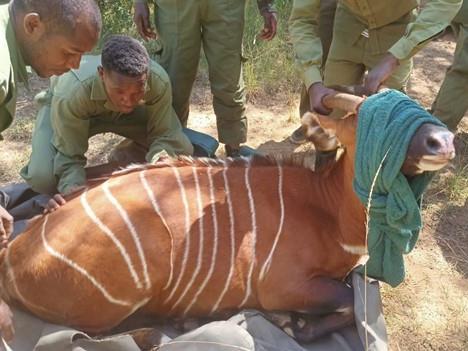
Immobilisation and relocation
The bongo was approached on foot and darted with 5mg Etorphine and 40mg Azaperone The dart was delivered on the musculature of the left rump, and the drug took effect after about 8 minutes with the animal on left lateral recumbency.
The animal was blindfolded to prevent light stimulation and loaded onto a stretcher. It was then lifted onto a moving truck where it was transported to another boma. During transportation, respiration was monitored by observation of chest expirations. Anaesthesia reversal was done with 100mg Naltrexone injected intravenously. The animal was standing 2 minutes post reversal.
Case
– 06th
5
February 2023
Rhino Rescue Ol Jogi Conservancy
Ol Jogi Rangers observed that this 3-day-old female black rhino calf was weak and unable to keep up with its mother.
Rescue
The Mt. Kenya Mobile Veterinary Unit was called in after the mother left the calf which later collapsed. Assessment of the calf indicated it was weak, lethargic and unable to walk. This was attributed to lack of milk from the mother due to the prevailing drought conditions.
The calf was rescued after permission was given by KWS Headquarters and taken to Ol Jogi wildlife nursery where it’s doing well.

–
Case 6
08th February 2023
Zebra Snared Pingwan, Rumuruti - Laikipia
An adult female Grevy’s zebra was reported to be limping and slow moving. The animal was also noted to be frequently lying down. Local scouts managed to see a snare on the animal and reported the matter.

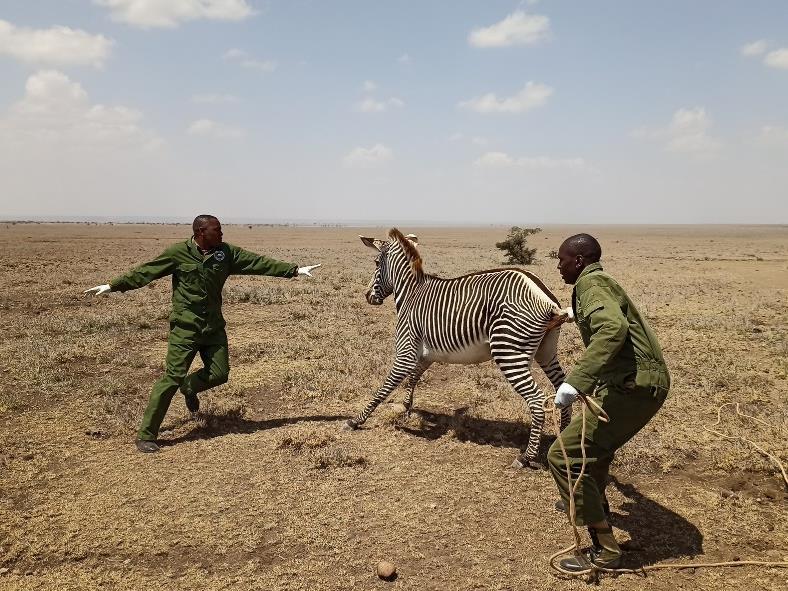

Immobilisation, examination and treatment
The zebra was approached on foot and darted with 6 mg Etorphine and 40 mg Azaperone on the musculature of the right shoulder. The drug took effect after about 8 minutes and the animal went down on left lateral recumbency. It was then blindfolded to prevent light stimulation. Examination of the right forelimb revealed a nylon snare that had cut into the tissues of limb at the level of the carpus. The snare was removed then the wound was debrided with Hydrogen peroxide and Iodine for topical antibiotic cover. Flunixin meglumine was given to manage pain and inflammation while Amoxicillin was given for systemic antibiotic cover. Multivitamins were also administered to boost the immune system. Anaesthesia was reversed with 120 mg Naltrexone injected intravenously. The animal recovered and was standing after 2 minutes.

Prognosis
The zebra has a good prognosis since the wounds were not extensive
Case 7 – 08th February 2023
Lion Human – Wildlife Conflict Lolomarik Farm, Laikipia
An adult male lion was reported to be preying on livestock at Lolomarik farm. The lion had recently preyed on and killed several animals, it was therefore deemed a problematic animal and a candidate for translocation to prevent further livestock attacks.


Immobilisation and relocation
The lion was darted with 4mg Medetomidine and 300mg Ketamine using a Dan-Inject® CO2 rifle. The animal was darted on foot. It was collared for monitoring purposes and safely translocated and released in Meru National Park.


Case 8 – 09th February 2023
Bongo Post-mortem Mt. Kenya Wildlife Conservancy
A female mountain bongo calf died during the night on 08th February 2023 shortly after being born
Post-mortem findings
The post-mortem examination revealed generalised kidney congestion indicative of possible acute renal dysfunction, acute pneumonia shown by froth in the trachea and congestion of lungs, and predation wounds on the perineal area by a small carnivore.
There was no significant pathology observed in other body systems.
Cause of death
The immediate cause of death was found to be acute pneumonia.
Unfortunately, there are no pictures for this case.
Case 9 – 09th February
2023
Rhino Post-mortem Solio Ranch
An adult male white rhino carcass was reported to have been found in a river within solio ranch. The Mt Kenya veterinary unit performed an autopsy on the carcass to determine the cause of death.

Post-mortem findings
There were deep puncture wounds on the right chest area just behind the right forelimb. They went through the skin, muscles, broke one of the thoracic ribs and punctured the right lung leading to massive blood loss and infection. Blood was observed in the thoracic cage and the lungs.
Cause of death
The rhino died from shock through blood loss and drowning in blood after it sustained injuries in a territorial fight with another rhino bull.
Case 10 – 10th February 2023
Bongo Natural Causes
Mt. Kenya Wildlife Conservancy
An adult female mountain bongo was reported to be limping by the conservancy monitoring team.

Immobilisation, examination and treatment
The bongo was approached on foot and darted with 5 mg Etorphine hydrochloride and 40 mg Azaperone tartate using a Dan-Inject® CO2 rifle. The dart was landed on the musculature of the right thigh, and the drug took effect after about 6 minutes with the animal going down on lateral recumbency. Oxygen was supplemented intra-nasally and a blindfold was placed over the eyes to prevent light stimulation. Examination of the right forelimb revealed a cracked hoof. The wound was cleaned with Iodine then healing clay was applied on it to protect it as it heals. Amoxicillin was administered for systemic antibiotic cover and Flunixin meglumine for inflammation and pain control. The other hooves were also examined and trimmed. Anaesthesia reversal was done with 100 mg Naltrexone injected intravenously. The animal recovered and was standing 2 minutes later.

Prognosis
The bongo has a good prognosis.
–
Case 11
13th February 2023
Elephant Snared Buffalo Springs National Reserve
A sub-adult male elephant was reported to be lame with a snare noted on its left hindlimb.

Immobilisation, examination and treatment
The elephant was darted from a vehicle and immobilised with 7 mg Etorphine. The dart landed on the musculature of the right rump. Induction time was 7 minutes, and the animal went down in left lateral recumbency. A snare wound was observed on the left hindlimb but, the snare had fallen off after injuring the surrounding tissues. The wound was debrided with Hydrogen peroxide and Iodine for topical antibiotic cover. It was then sealed with healing clay and topical antibiotic spray applied. Amoxicillin was given intramuscularly for systemic antibiotic cover and Phenylbutazone administered to manage pain and inflammation. Anaesthesia was reversed with 140 mg Naltrexone administered through the ear vein. The animal stood 3 minutes post-reversal.
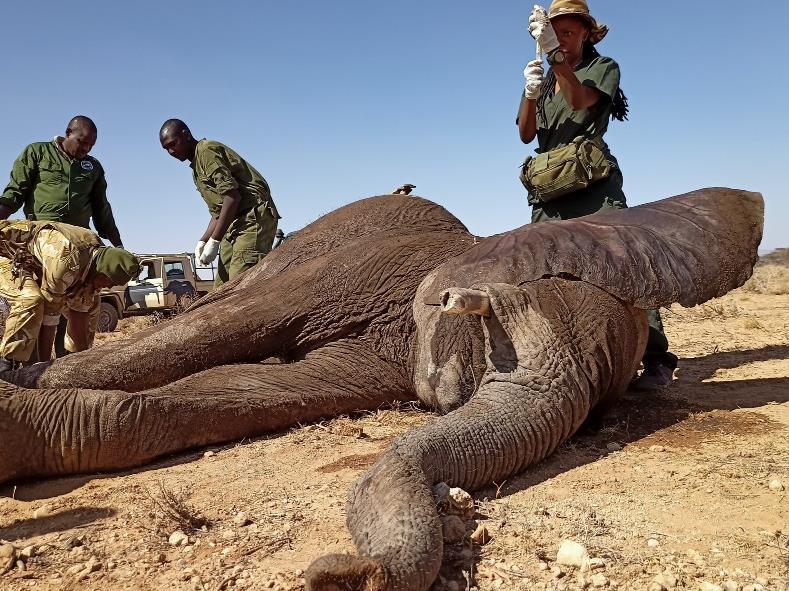
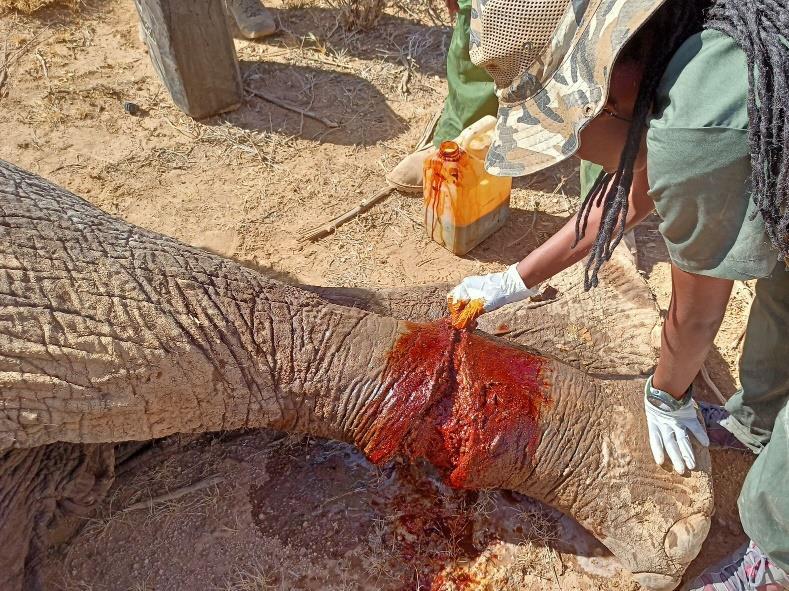
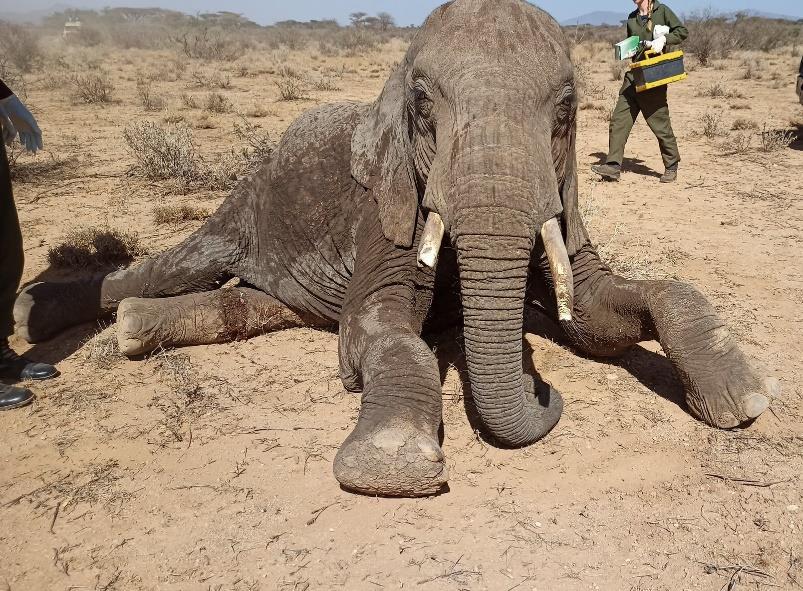
Prognosis
The elephant has a good prognosis since the injury was not severe.
Case 12– 13th February 2023
Rhino Technical Case Ol Pejeta Conservancy
2 female southern white rhinos, Curra and Dali, who are to be surrogates for the Northern White Rhino embryos were immobilised and reproductive ultrasounds performed on them

Immobilisation and examination
The animals were immobilised with a non-Etorphine protocol, a combination of Medetomidine, Butorphanol, Midazolam and Ketamine was employed. For maintenance of anaesthesia the drugs were administered in accordance with the physiological response and anaesthesia parameters of the animal. Ringers lactate drip was administered intravenously at a flow rate of 14 mls/minute. A total of 4,000 mls was administered. Oxygen was delivered at a constant rate of 10 mmHg through a nasal tube.
Results
Curra - The ultrasound confirmed that there was an embryo that had implanted on the right uterine horn near the oviduct junction. The embryo had formed an embryo vesicle and had a heart rate.
Dali - Confirmed as not pregnant despite having been mated end of November. Her uterus was healthy with the right ovary having two follicles while the left ovary had many follicles and ovulation had occurred. There were also indications that she had been mated the night before and there was presence of ejaculate
Case 13 – 14th February 2023
Rhino Technical Case Ol Pejeta Conservancy
Ouwan, a mature free-ranging southern white rhinoceros bull was to be prepared as a teaser bull for heat detection in Northern white rhino females. The animal had been captured in the wild at the Lewa Conservancy and translocated to the Ol Pejeta Conservancy where it was housed in a boma. Vasectomy had been performed on the animal in December 2021 therefore electroejaculation was to be performed to determine whether the sterilization was successful. If there was presence of sperm on microscopic examination, the vasectomy would be performed again.
Immobilisation and electroejaculation
A non-opioid anaesthesia protocol was used to prevent respiratory depression associated with opioid use since the procedure was lengthy. The rhino was darted on the left neck muscle at 8:00 am with a 10 ml Daninject® dart powered by a Telinject® CO2 pistol. The dart contained 20 mg Medetomidine, 200 mg Butorphanol and 750 mg Ketamine. The animal became recumbent 6 minutes after darting. Combinations of various drugs were used to manage anaesthesia during the procedure.
Once the rhinoceros was sedated, ropes were used to anchor the rear legs and the procedure began. Electrical stimulation was administered using an electro ejaculator at a voltage of 5 volts. Semen was then collected and examined for presence of spermatozoa.
Results
The collected semen revealed presence of highly motile spermatozoa in low concentration indicating possibility of another procedure in future. Anaesthesia was reversed at 9.08 am with 50 mg Atipamezole (given intramuscularly), 100 mg Atipamezole (given intravenously) and 200 mg Naltrexone (given intravenously). 2 minutes post-reversal, the animal was up slightly ataxic and standing.
Unfortunately, there are no pictures for this case.
Case 14 – 15th February
2023
Case 15 – 15th February 2023
Elephant Bullet wound Daaba, Isiolo County




This sub-adult male elephant was reported to be lame.
Immobilisation, examination and treatment
The elephant was immobilised with 16 mg Etorphine hydrochloride delivered with a Dan-Inject® CO2 rifle fired from vehicle. The dart landed on the musculature of the left rump. Induction time was 7 minutes, and the animal went down in left lateral recumbency. Upon examination it was noted that the elephant had a penetrating wound on the inner left forelimb at the level of the distal ulna, suspected septic arthritis on the right elbow, and a possible closed fracture. The wounds were possibly caused by bullets. The wound was debrided with Hydrogen peroxide and Iodine for topical antibiotic cover. Antibiotic pessaries were inserted into the wound then the wound was sealed with healing clay and topical antibiotic spray applied. Amoxicillin was given intramuscularly for systemic antibiotic cover and Phenylbutazone administered to manage pain and inflammation. Multivitamins were also given to boost immunity. Anaesthesia was reversed with 300 mg Naltrexone administered through the ear vein. The animal was assisted to stand with ropes and was on all fours 3 minutes post-reversal.
Prognosis
Prognosis is guarded. Nakuprat rangers were requested to monitor the animal.
Elephant Natural Causes Buffalo Springs National Reserve
An adult matriarch was reported to have notable lameness.
Immobilisation, examination and treatment
The elephant was darted from a vehicle with a 15 mg Etorphine hydrochloride dart discharged from a DanInject® CO2 rifle. The dart landed on the musculature of the right rump, and the animal went down in left lateral recumbency 5 minutes later. The elephant’s calf was driven away to be with the rest of the family. Examination of the limbs revealed no external injuries, but a dislocation of the right carpal joint was noted. Pen-Strep® was given intramuscularly for systemic antibiotic cover and Phenylbutazone administered to manage pain and inflammation. Anaesthesia reversal was done with 300 mg Naltrexone administered through the ear vein. The animal was standing 3 minutes later.


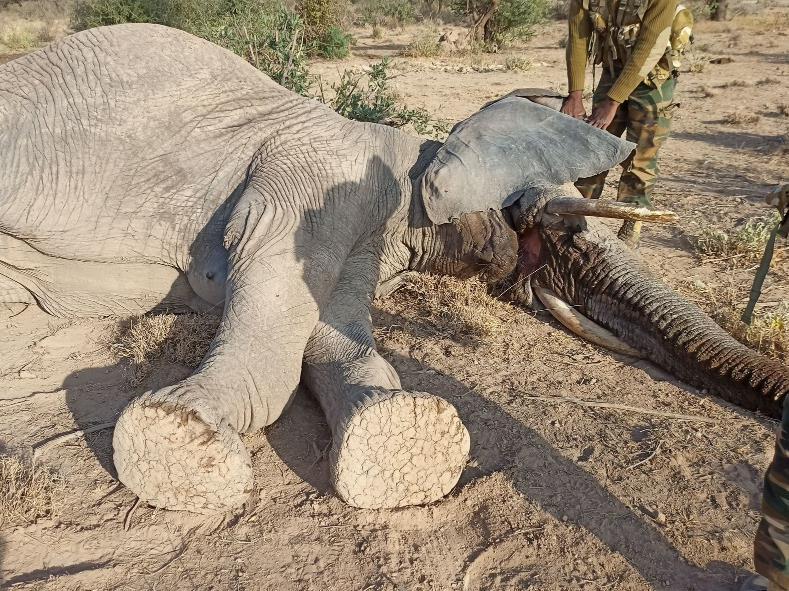
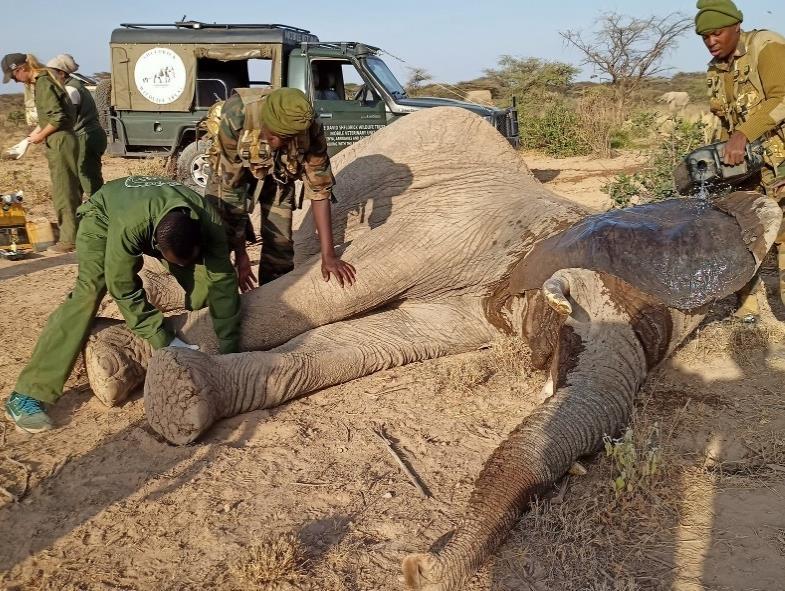
Prognosis
The elephant has a good prognosis since the injury was not severe.
Case 16 – 15th February 2023
Bongo Post-mortem Mt. Kenya Wildlife Conservancy
The monitoring team reported that an adult female mountain bongo had died the previous night.
Post-mortem findings
The post-mortem examination revealed pneumonia and generalised haemorrhage.
There was no significant pathology observed in other body systems.
Cause of death
The immediate cause of death was hypovolemic shock caused by haemorrhage from trauma.
Unfortunately, there are no pictures for this case.
–
th
Case 17
15
February 2023
Elephant Natural Causes Ol Pejeta Conservancy

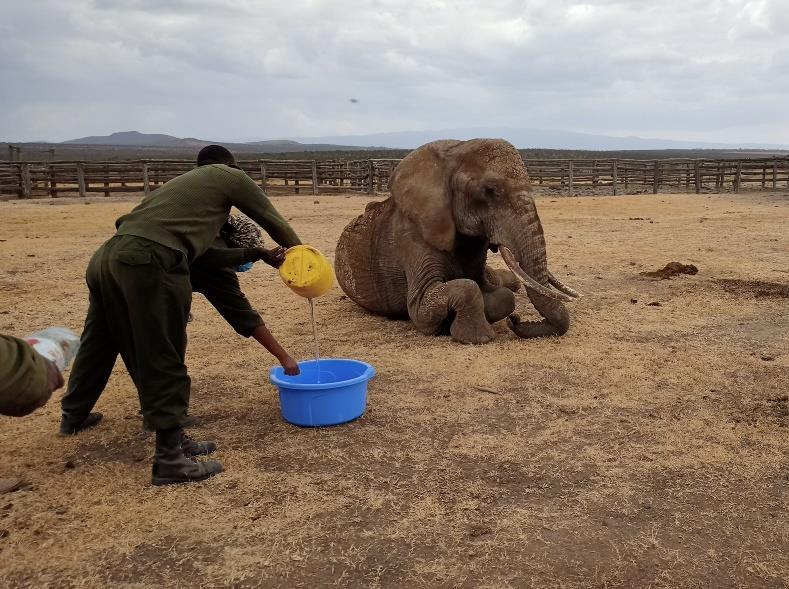

An adult female elephant was reported to be weak and recumbent.
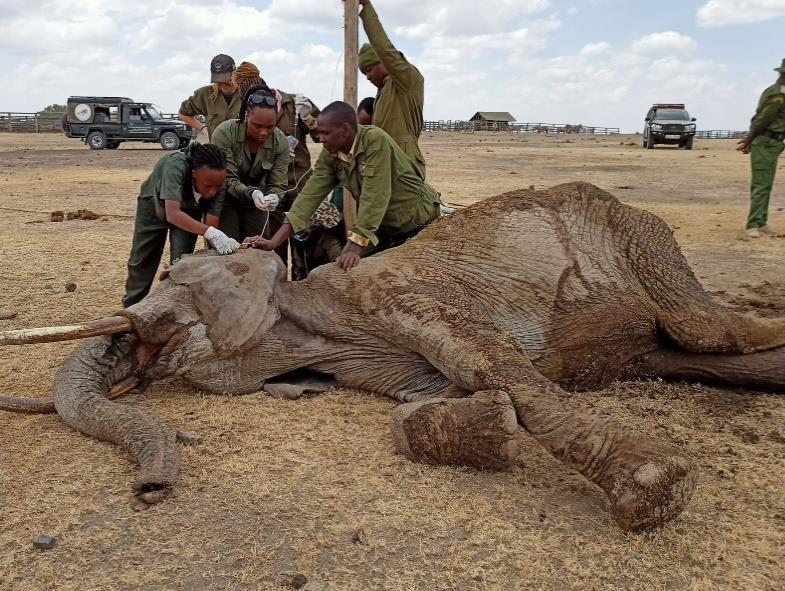
Examination and treatment
Examination of the animal revealed no external injuries. Intravenous fluids, Dexamethasone and a metabolic stimulant were administered to give the animal energy and metabolic stimulation. Thereafter, ropes were used to assist the animal to stand. Unfortunately, the elephant was too weak to stand.
Prognosis
The elephant has a guarded to poor prognosis since it was in poor condition
Case 18 – 17th February 2023
Buffalo Human – Wildlife Conflict Sarara, Namunyak Conservancy - Samburu
An adult male buffalo was reported to have a spear lodged in its flank. The buffalo was in a herd of three bulls, the buffalo had reportedly attacked someone in the neighbouring community leading to it being speared.
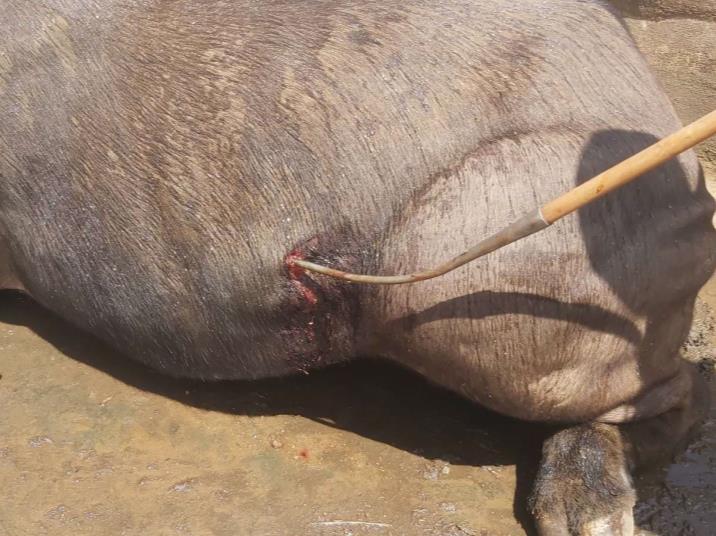

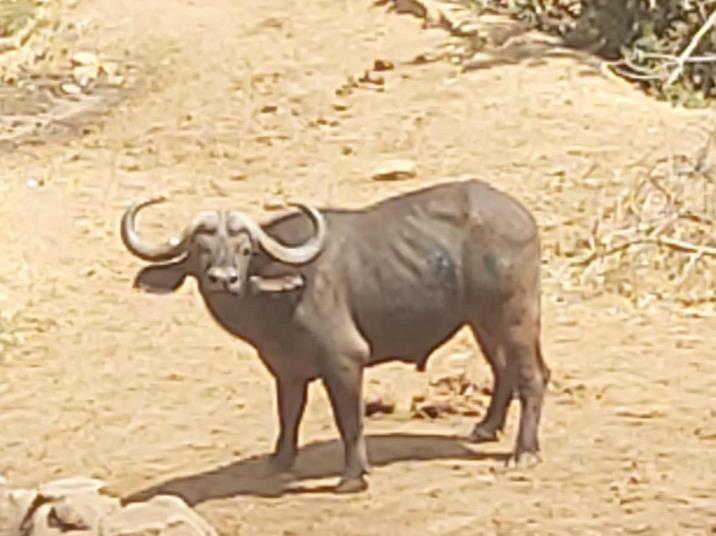

Immobilisation, examination and treatment
The buffalo was approached on foot and darted with 5 mg Etorphine hydrochloride and 50 mg Azaperone. The dart was landed on the musculature of the right rump.
The spear was carefully removed; fortunately, no major internal organs were perforated. Amoxicillin was given intramuscularly for systemic antibiotic cover and Flunixin meglumine administered to manage pain and inflammation. Anaesthesia was reversed with 100 mg Naltrexone administered through the ear vein. The animal was standing 3 minutes later
Prognosis
The buffalo has a good prognosis since the spear had not punctured any major organs. The animal is expected to recover well.
Case 19 – 22nd February 2023
Elephant Spear Kirimon, Laikipia
A young elephant bull was reported to have a wound on the lumbar area suspected to have been inflicted by a spear.
Immobilisation, examination and treatment
A KWS helicopter herded the young elephant bull from a gorge to a flat area where it was darted from the helicopter with 8 mg Etorphine hydrochloride discharged from a Dan-Inject® CO2 rifle The helicopter then herded the elephant to a clearing where it went down on lateral recumbency.


It was observed that the elephant had a penetrating wound on the lumbar area caused by an unknown sharp object. The wound was flushed with Hydrogen peroxide and Iodine. It was then sprayed with Oxytetracycline before being covered with green clay. Long-acting Amoxicillin and Dexamethasone were administered intramuscularly before anaesthesia was reversed with 160 mgs Naltrexone administered through the ear vein.
Prognosis
The elephant has a good prognosis since the injury was not severe.
Case 20 – 26th February 2023



 Jeremiah Poghon
Jeremiah Poghon




















































